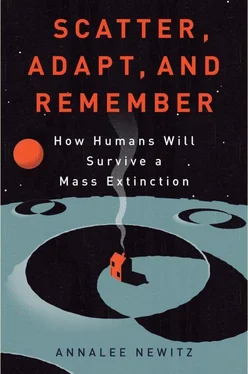Many anthropologists believe that the truth lies somewhere in between African replacement and multiregionalism. Perhaps there were a few distinct waves of migration, such anthropologists will concede, but H. sapiens didn’t “replace” the Neanderthals. Instead, H. sapiens bands probably assimilated their unusual cousins through the early human version of intermarriage.
Perhaps, when Neanderthals stood in the smooth stone entries to their caves and watched H. sapiens first entering their wooded valleys, they saw opportunity rather than a confusing threat. In this version of events, our ancient human siblings may have had few resources and lived a hardscrabble life, but they were H. sapiens ’ mental equals. They exchanged ideas with the newcomers, developed ways of communicating, and raised families together. Their hybrid children deeply affected the future of our species, with a few of the most successful Neanderthal genes drifting outward into some of the H. sapiens population. Neanderthals went extinct, but their hybrid children survived by joining us.
Whether you believe that humans exterminated or assimilated Neanderthals depends a lot on what you believe about your own species. Klein doesn’t think Neanderthals were inferior humans doomed to die—he simply believes that early H. sapiens would have been more likely to kill and rape their way across Europe in a Neanderthal holocaust, rather than making alliances with the locals. As his comment about the sexual predilections of modern men makes clear, Klein is basing his theory on what he’s observed of H. sapiens in the contemporary world. Tattersall amplified Klein’s comments by saying that he thinks humans 40,000 years ago probably treated Neanderthals the way we treat each other today. “Today, Homo sapiens is the biggest threat to its own survival. And [the Neanderthal extinction] fits that picture,” he said. Ultimately, Tattersall believes that we wiped out the Neanderthals just the way we’re wiping ourselves out today.
Hawks, on the other hand, described a more complicated relationship between H. sapiens and Neanderthals. He believes that Neanderthals had the capacity to develop culture, but simply didn’t have the resources. “They made it in a world where very few of us would make it,” he said, referring to the incredible cold and food scarcity in the regions Neanderthals called home. Anthropologists, according to Hawks, often ask the wrong questions of our extinct siblings: “Why didn’t you invent a bow and arrow? Why didn’t you build houses? Why didn’t you do it like we would?” He thinks the answer isn’t that the Neanderthals couldn’t but that they didn’t have the same ability to share ideas between groups the way H. sapiens did. Their bands were so spread out and remote that they didn’t have a chance to share information and adapt their tools to life in new environments. “They were different, but that doesn’t mean there was a gulf between us,” Hawks concluded. “They did things working with constraints that people today have trouble understanding.” Put another way, Neanderthals spent all day in often fatal battles to get enough food for their kids to eat. As a result, they didn’t have the energy to invent bows and arrows in the evening. Despite these limitations, they formed their small communities, hunted collectively, cared for each other, and honored their dead.
When H. sapiens arrived, Neanderthals finally had access to the kind of symbolic communication and technological adaptations they’d never been able to develop before. Ample archaeological evidence shows that they quickly learned the skills H. sapiens had brought with them, and started using them to adapt to a world they shared with many other groups who exchanged ideas on a regular basis. Instead of being driven into extinction, they enjoyed the wealth of H. sapiens ’ culture and underwent a cultural explosion of their own. To put it another way, H. sapiens assimilated the Neanderthals. This process was no doubt partly coercive, the way assimilation so often is today.
More evidence for Hawks’s claims comes from Neanderthal DNA. Samples of their genetic material can reveal just what happened after all that Pleistocene hanky-panky. A group of geneticists at the Max Planck Institute, led by Svante Pääbo, sequenced the genomes of a few Neanderthals who had died less than 38,000 years ago. After isolating a few genetic sequences that appear unique to Neanderthals, they found evidence that a subset of these sequences entered the H. sapiens genome after the first contact between the two peoples. Though this evidence does not prove definitively that genes flowed from Neanderthals into modern humans, it’s a strong argument for an assimilationist scenario rather than extermination.
A big question for anthropologists has been whether H. sapiens comes from a “pure” lineage that springs from a single line of hominins like Mitochondrial Eve. The more the genetic evidence piles up, however, the more likely it seems that our lineage is a patchwork quilt of many peoples and cultures who intermingled as they spread across the globe. Present-day humans are the offspring of people who survived grueling immigrations, harsh climates, and Earth-shattering disasters.
Most anthropologists are comfortable admitting that we just don’t know what happened when early humans left Africa, and are used to revising their theories when new evidence presents itself. Klein’s influential textbook The Human Career is full of caveats about how many of these theories are under constant debate and revision. In 2011, for example, the anthropologist Simon Armitage published a paper suggesting that H. sapiens emerged from Africa as early as 200,000 years ago, settling in the Middle East. This flies in the face of previous theories, which hold that H. sapiens didn’t leave Africa until about 70,000 years ago. The story of how our ancestors emerged from their birthplaces in Africa turns out to be as complicated as a soap opera—and it likely includes just as much sex and death, too.
Who Survived to Tell the Tale?
Whether humans destroyed Neanderthals or merged with them, we’re left with a basic fact of anthropological history, which is that modern humans survived and Neanderthals did not. It’s possible that members of H. sapiens were better survivors than their hominin siblings because Neanderthals didn’t exchange symbolic information; they were too sparse, spread out, and impoverished to achieve a cultural critical mass the way their African counterparts did. But it seems that Neanderthals were still swept up into H. sapiens’ way of life in the end. Our Neanderthal siblings survive in modern human DNA because they formed intimate bonds with their new human neighbors.
Svante Pääbo, who led the Neanderthal DNA sequencing project, recently announced a new discovery that also sheds light on why H. sapiens might have been a better survivor than H. neanderthalensis . After analyzing a newly sequenced genome from a Denisovan, a hominin more closely related to Neanderthals than H. sapiens are, Pääbo’s team concluded that there were a few distinct regions of DNA that H. sapiens did not share with either Neanderthals or Denisovans. Several of those regions contain genes connected to the neurological connections that humans can form in their brains. In other words, it’s possible that H. sapiens ’ greater capacity for symbolic thought is connected to unique strands of DNA that the Neanderthals didn’t have.
“It makes a lot of sense to speculate that what had happened is about connectivity in the brain, because … Neanderthals had just as large brains as modern humans had,” Pääbo said at a press conference in 2012 after announcing his discovery. “Relative to body size, they had even a bit larger brains [than H. sapiens ]. Yet there is something special that happens with modern humans. It’s sort of this extremely rapid technological cultural development and large societal systems, and so on.” In other words, H. sapiens ’ brains were wired slightly differently than their fellow hominins. And once Neanderthals merged with H. sapiens ’ communities, bearing children with the new arrivals, their mixed offspring may have had brains that were wired differently, too. Looked at in this light, it’s as if H. sapiens assimilated Neanderthals both biologically and culturally into an idea-sharing tradition that facilitated rapid adaptation even to extremely harsh conditions.
Читать дальше






![Аннали Ньюиц - Автономность [litres]](/books/424681/annali-nyuic-avtonomnost-litres-thumb.webp)





